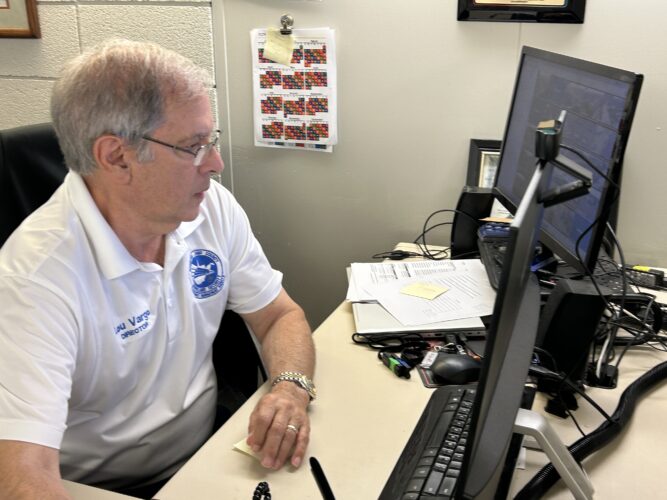Vargo looks back on Wheeling-area flood response

SERVING AREA — Lou Vargo, director of the Ohio County Emergency Management Agency, handles day-to-day operations in the county’s emergency operations center. -- Joselyn King
WHEELING — Ohio County Emergency Management Director Lou Vargo said “it’s the little things that keep you going” during a crisis — like donated sandwiches, cookies, coffee and a bag of “thank you” notes from local school children.
Vargo said that following flooding that hit the county on June 14, he and Assistant Director Tony Campbell each put in about 156 hours of work during an 80-hour pay period.
“But that’s what we chose to do — to serve the people and get the city and county to respond to residents,” Vargo said. “That’s just the number of hours we had to put in to meet the needs.”
During the daylight hours, there was the search for missing people that later turned to recovery efforts. At night, there were hours spent on the phone with state and federal officials discussing the flood and the immediate needs of residents, he noted.
“Why we had a successful response and recovery is that we had a great team approach,” Vargo explained.
He credited local officials, first responders, and 911 dispatchers for the success, as well as coordinated efforts with the West Virginia National Guard.
“Everybody just did their job, and they knew what to do,” he said. “It was just a great team effort.
“It’s just how I would have imagined. That’s what we train for. That’s what we have drills for.”
Then there were all the volunteers and donations that immediately started to come into the effort as the flood waters started to subside.
There were also calls of support that came in at night. He remembers speaking at length with U.S. Sen. Shelley Moore Capito, R-W.Va., who personally called to check in on Vargo and see what she could do for the county.
Vargo keeps the shiny gift bag filled with scribbles from toddlers saying “thank you” and “we love you” on his desk.
“That’s how you get through things like this”, Vargo said.
Vargo has been with the Ohio County Emergency Management Agency for 35 years.
The destruction he saw happen on the night of June 14 in the towns of Triadelphia and Valley Grove was the worst he had ever seen.
At least 37 homes so far have been determined to be off their foundations or destroyed as a result of the event, he said.
“In my 35 years in Ohio County, obviously we’ve never seen a flood with this many fatalities (nine), or with this much devastation, ” Vargo said. “We’ve had flash flooding before, we’ve had river flooding before.
“With river flooding, we usually have basement flooding or even first-floor flooding. In past flash flooding, we’ve even had mobile homes off their foundations and on top of each other – but never to the point we’ve had 37 houses destroyed.”
Then there was all the debris that was left behind. About 1,000 tons of debris was removed by West Virginia National Guard alone, according to Vargo.
“The debris removal is more than we’ve ever had to do, and just the destruction is unlike anything we’ve ever seen before,” he said.
There had been reports from the National Weather Service earlier in the day that flooding was possible on the night of June 14.
Vargo said he watched the storm brew from his house, and viewed the radar on his phone.
“I live at the end of Washington Avenue, and I had never seen rains so intense,” he continued. “Within 12 minutes, we started to get the first 911 calls.
“I went immediately out to Triadelphia where the first calls were coming from. But on my way, visibility was so hard because the rain was coming down so hard.”
As he was driving, Vargo said he heard radio calls reporting people in the creek. He called for the Wheeling Fire Department to activate their swiftwater rescue team.
After this, all local volunteer fire departments were activated to go to the Valley Grove and Triadelphia area.
Vargo said he went out with Triadelphia Fire Chief Dave Patterson and some members from the Stone Church VFD and helped rescue two people from a building.
Water was starting to wash out roads by this time, and Vargo said he and Campbell then decided to activate the Emergency Operations Center.
The first thing they did was contact Wheeling City Manager Robert Herron and the Ohio County commissioners to have states of emergency declared at both the city and county level. Those declarations were passed on to Gov. Patrick Morrisey, who declared a state of emergency in Ohio County the following day.
The role at the Emergency Operations Center “is keeping and coordinating control of everything that is going on,” Vargo explained. They set up five area command centers located in Elm Grove, at Riesbecks, the Valley Grove Fire Department, the Triadelphia Community Center, and the Department of Highways garage in Triadelphia.
“Then as we were getting calls, we were getting them out to the various command centers,” he explained.
Vargo noted after the flood waters subsided the next step was to gather flood assessment information from those affected. Among the most beneficial items donated were ATVs and side-by-sides from Wheeling Volkswagen and Subaru in Triadelphia and others in the community. These were used to get to people in areas left inaccessible during the flood.
“There was a swarm of ATVs going out to people, and if they couldn’t get on the internet we had hot spots and paper forms they could fill out,” Vargo said. “I really think that is what led us to this (federal emergency) declaration.”
He also spoke of the involvement of the Ohio County Health Department, who provided more than 1,800 shots for tetanus and hepatitis during the emergency. They were assisted by workers from the Marshall and Brooke county health departments, and other health departments sent additional vaccines.
Vargo had a career as a nurse anesthetist for 40 years prior to becoming the Ohio County EMA director.
He was born in Mount Pleasant and became a junior firefighter at age 16. As an adult, Vargo trained to be a nurse at Ohio Valley Medical Center and continued his nursing career there.
He would head up the emergency squad in Mt. Pleasant, eventually becoming fire chief. He also would teach emergency training classes at the former Belmont Technical College.
Vargo would team with one of his best friends – then Wheeling Fire Chief Cliff Sligar – to start the paramedic program at the Wheeling Fire Department.
“That program has grown to become one the best advanced life support programs in the country,” he said.
He would take on a part-time position with the Ohio County EMA in 1990 before becoming its director following the death of John Tagg in 2010.
“Back then, I was just helping with the Ohio County Office of Emergency Services, and because of my flexible schedule with anesthesia I was able to do that part-time,” Vargo said.
He took on the job full-time later in an effort to build up an ambulance and paramedic service for Ohio County. The service began operating in January 2020.
Vargo said his next move in the recovery effort will be to do an after action report analyzing the local response on June 14.
“We are going to gather everybody — especially the emergency operations staff, the different chiefs and departments, the sheriff – and get them into a big room,” he said. “We are going to ask them, ‘What did we do right? What did we do wrong? And how can we improve?’
“Even when you have an event like a severe motor vehicle accident – or a flash flood with this much devastation — how you learn from that is you look at the plans and how you responded to it. Some things worked, some things didn’t, and we’re going to learn from it. We’re going to drill with it. We just have to get better,” Vargo explained.



